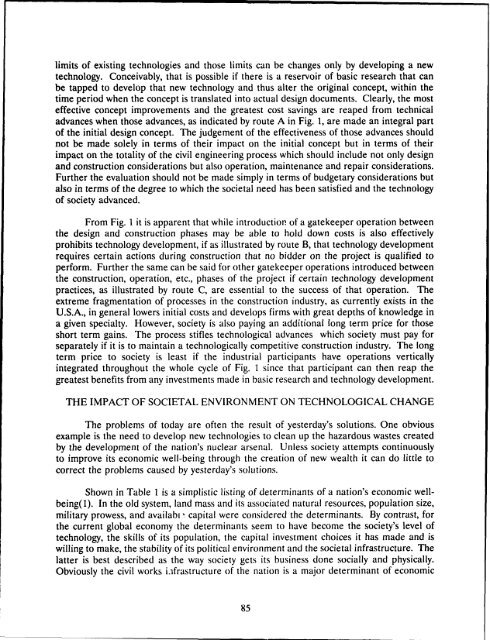Challenges and Opportunities for Innovation in the Public Works ...
Challenges and Opportunities for Innovation in the Public Works ...
Challenges and Opportunities for Innovation in the Public Works ...
Create successful ePaper yourself
Turn your PDF publications into a flip-book with our unique Google optimized e-Paper software.
limits of exist<strong>in</strong>g technologies <strong>and</strong> those limits can be changes only by develop<strong>in</strong>g a new<br />
technology. Conceivably, that is possible if <strong>the</strong>re is a reservoir of basic research that can<br />
be tapped to develop that new technology <strong>and</strong> thus alter <strong>the</strong> orig<strong>in</strong>al concept, with<strong>in</strong> <strong>the</strong><br />
time period when <strong>the</strong> concept is translated <strong>in</strong>to actual design documents. Clearly, <strong>the</strong> most<br />
effective concept improvements <strong>and</strong> <strong>the</strong> greatest cost sav<strong>in</strong>gs are reaped from technical<br />
advances when those advances, as <strong>in</strong>dicated by route A <strong>in</strong> Fig. 1, are made an <strong>in</strong>tegral part<br />
of <strong>the</strong> <strong>in</strong>itial design concept. The judgement of <strong>the</strong> effectiveness of those advances should<br />
not be made solely <strong>in</strong> terms of <strong>the</strong>ir impact on <strong>the</strong> <strong>in</strong>itial concept but <strong>in</strong> terms of <strong>the</strong>ir<br />
impact on <strong>the</strong> totality of <strong>the</strong> civil eng<strong>in</strong>eer<strong>in</strong>g process which should <strong>in</strong>clude not only design<br />
<strong>and</strong> construction considerations but also operation, ma<strong>in</strong>tenance <strong>and</strong> repair considerations.<br />
Fur<strong>the</strong>r <strong>the</strong> evaluation should not be made simply <strong>in</strong> terms of budgetary considerations but<br />
also <strong>in</strong> terms of <strong>the</strong> degree to which <strong>the</strong> societal need has been satisfied <strong>and</strong> <strong>the</strong> technology<br />
of society advanced.<br />
From Fig. 1 it is apparent that while <strong>in</strong>troductioo, of a gatekeeper operation between<br />
<strong>the</strong> design <strong>and</strong> construction phases may be able to hold down costs is also effectively<br />
prohibits technology development, if as illustrated by route B, that technology development<br />
requires certa<strong>in</strong> actions dur<strong>in</strong>g construction that no bidder on <strong>the</strong> project is qualified to<br />
per<strong>for</strong>m. Fur<strong>the</strong>r <strong>the</strong> same can be said <strong>for</strong> o<strong>the</strong>r gatekeeper operations <strong>in</strong>troduced between<br />
<strong>the</strong> construction, operation, etc., phases of <strong>the</strong> project if certa<strong>in</strong> technology development<br />
practices, as illustrated by route C, are essential to <strong>the</strong> success of that operation. The<br />
extreme fragmentation of processes <strong>in</strong> <strong>the</strong> construction <strong>in</strong>dustry, as currently exists <strong>in</strong> <strong>the</strong><br />
U.S.A., <strong>in</strong> general lowers <strong>in</strong>itial costs <strong>and</strong> develops firms with great depths of knowledge <strong>in</strong><br />
a given specialty. However, society is also pay<strong>in</strong>g an additional long term price <strong>for</strong> those<br />
short term ga<strong>in</strong>s. The process stifles technological advances which society must pay <strong>for</strong><br />
separately if it is to ma<strong>in</strong>ta<strong>in</strong> a technologically competitive construction <strong>in</strong>dustry. The long<br />
term price to society is least if <strong>the</strong> <strong>in</strong>dustrial participants have operations vertically<br />
<strong>in</strong>tegrated throughout <strong>the</strong> whole cycle of Fig. 1 s<strong>in</strong>ce that participant can <strong>the</strong>n reap <strong>the</strong><br />
greatest benefits from any <strong>in</strong>vestments made <strong>in</strong> basic research <strong>and</strong> technology development.<br />
THE IMPACT OF SOCIETAL ENVIRONMENT ON TECHNOLOGICAL CHANGE<br />
The problems of today are often <strong>the</strong> result of yesterday's solutions. One obvious<br />
example is <strong>the</strong> need to develop new technologies to clean up <strong>the</strong> hazardous wastes created<br />
by <strong>the</strong> development of <strong>the</strong> nation's nuclear arsenal. Unless society attempts cont<strong>in</strong>uously<br />
to improve its economic well-be<strong>in</strong>g through <strong>the</strong> creation of new wealth it can do little to<br />
correct <strong>the</strong> problems caused by yesterday's solutions.<br />
Shown <strong>in</strong> Table 1 is a simplistic list<strong>in</strong>g of determ<strong>in</strong>ants of a nation's economic wellbe<strong>in</strong>g(l).<br />
In <strong>the</strong> old system, l<strong>and</strong> mass <strong>and</strong> its associated natural resources, population size,<br />
military prowess, <strong>and</strong> availabi • capital were considered <strong>the</strong> determ<strong>in</strong>ants. By contrast, <strong>for</strong><br />
<strong>the</strong> current global economy <strong>the</strong> determ<strong>in</strong>ants seem to have become <strong>the</strong> society's level of<br />
technology, <strong>the</strong> skills of its population, <strong>the</strong> capital <strong>in</strong>vestment choices it has made <strong>and</strong> is<br />
will<strong>in</strong>g to make, <strong>the</strong> stability of its political environment <strong>and</strong> <strong>the</strong> societal <strong>in</strong>frastructure. The<br />
latter is best described as <strong>the</strong> way society gets its bus<strong>in</strong>ess done socially <strong>and</strong> physically.<br />
Obviously <strong>the</strong> civil works <strong>in</strong>afrastructure of <strong>the</strong> nation is a major determ<strong>in</strong>ant of economic<br />
85







